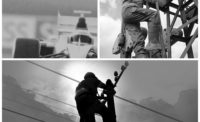Physiological & psychological effects
High performance fabrics were originally created to boost athletes’ performance in extreme outdoor situations by keeping them drier and cooler in hot conditions and warmer in cold weather. There are both physiological and psychological effects at play. Keeping the body cooler by facilitating thermoregulation (your body’s cooling mechanism) is a physiological advantage. The psychological advantage comes from knowing garments won’t become more uncomfortable by being weighed down with excessive moisture.
A bit of history
When moisture-wicking fabrics first appeared in the market more than 20 years ago, they were synthetic (polyester) with a moisture-wicking finish applied. Unfortunately, these chemically treated fabrics typically lost their ability to wick moisture with each machine washing.
The next generation of fabrics combined hydrophobic (water-hating) fibers and hydrophilic (water-loving) fibers. Hydrophobic fibers are still synthetic, and include nylon, aramids and modacrylics. Hydrophilic fibers – cotton, wool and lyocell, among others – feel good next to the skin. A proper blend of these fibers added more comfort – such as the feel of cotton – close to the body while pulling moisture to the outside of the fabric for quick drying times.
New standardized testing began to scientifically measure the wicking time of fabrics in seconds, minutes and inches. This proved that the new fabric blends actually wicked moisture, but if a fabric wicks moisture a few seconds faster than another, is it truly better?
The right blend of fibers
It is important to know how fast fabrics wick and dry. Fabrics that don’t wick leave moisture trapped against the skin, retaining heat and encouraging heat rash. Fabrics that wick but don’t dry as fast are less comfortable and may not have the ideal blend of fibers. If the hydrophilic fiber content is too high, the fabric will tend to hold more moisture and dry slower. Drying time is one of the most important attributes of performance because it’s key to effective thermoregulation.
Scientists developing new fabric technologies have focused on achieving the optimal fiber blend by increasing the performance qualities of yarns and fabrics without sacrificing the comfort and feel of natural fibers. Today, most of the world’s top athletic brands use these fast-drying, temperature-regulating blends.
Ultimate protection
High performance FR garments offer the ultimate combination of flame resistance in addition to moisture wicking and comfort. FR provides a potentially life-saving layer of protection to workers across a number of industries. Garments and undergarments made with fabrics that meet or exceed FR compliance ensure that wearers stay safe – as well as comfortable – in a wide range of work environments. Often, FR garments can be layered to achieve greater levels of protection without compromising performance.
Head off heat stress
Our bodies work to maintain a constant temperature of 98.6 degrees Fahrenheit. As the body experiences different levels of heat stress, including heat exhaustion and heat stroke, the body’s temperature can reach dangerous levels up to 104 degrees. Every year, on average, more than 4,000 heat-related illnesses are reported – and more than 30 deaths occur.
All garments on a body, whether FR or not, can be a contributing factor to heat-related injuries. Moisture-soaked garments can act like an insulation barrier and cause higher chest/body temperatures that increase chances for heat stress. If garments dry faster, heat is reduced within your body.
Staying cool just makes sense
Many companies in the apparel and protection industry claim to have comfortable garments; the true test of comfort is how garments perform in the field, not what’s claimed on the packaging. To regulate body temperature in the winter, wear lightweight layers that wick moisture, including outerwear. Lighter weight and moisture wicking are two garment characteristics recognized by OSHA in combating heat stress. It’s also your best strategy for the summer months.
All high performance garments are designed to optimize human achievement. The next time you choose an FR garment to wear, be sure it meets the standard of the hazard first, then ask how quickly it dries. Comfort is subjective; performance and protection are not.

